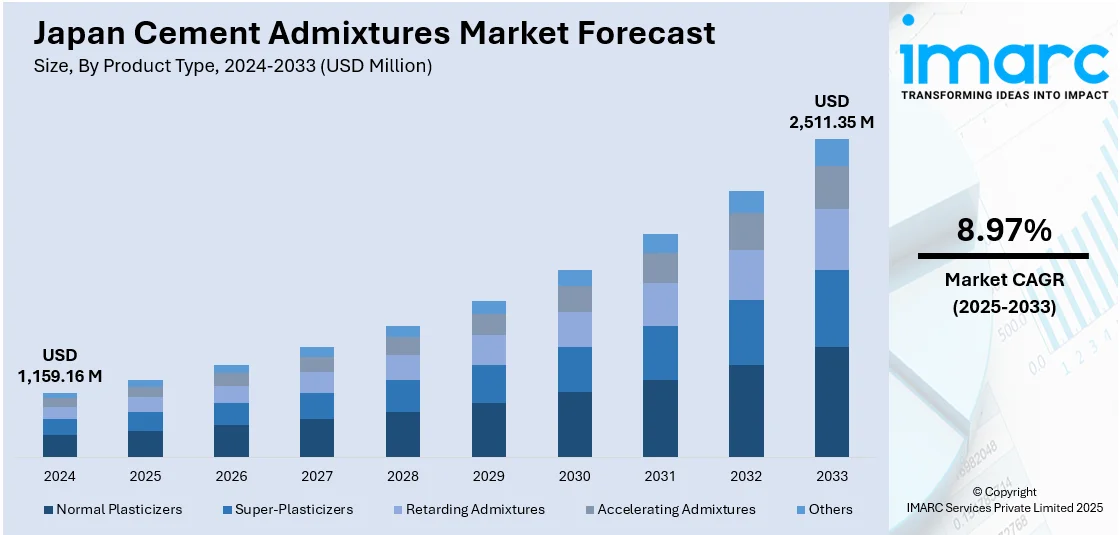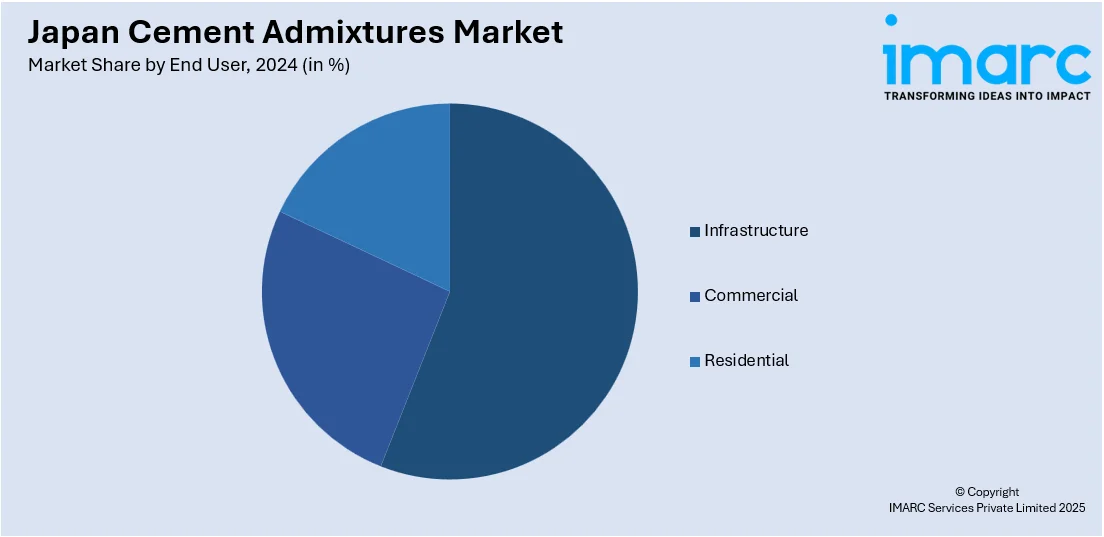
Japan Cement Admixtures Market Size, Share, Trends and Forecast by Product Type, End User, and Region, 2025-2033
Japan Cement Admixtures Market Overview:
The Japan cement admixtures market size reached USD 1,159.16 Million in 2024. Looking forward, IMARC Group expects the market to reach USD 2,511.35 Million by 2033, exhibiting a growth rate (CAGR) of 8.97% during 2025-2033. Japan's infrastructure development and seismic activity are driving the demand for advanced cement admixtures. These additives enhance concrete's strength, durability, and resilience to environmental influences, guaranteeing the durability of large-scale projects and earthquake-resistant structures. The need for these materials is increasing the focus on sustainability and seismic resilience and contributing to the Japan cement admixtures market share.
|
Report Attribute
|
Key Statistics
|
|---|---|
|
Base Year
|
2024
|
|
Forecast Years
|
2025-2033
|
|
Historical Years
|
2019-2024
|
| Market Size in 2024 | USD 1,159.16 Million |
| Market Forecast in 2033 | USD 2,511.35 Million |
| Market Growth Rate 2025-2033 | 8.97% |
Japan Cement Admixtures Market Trends:
Infrastructure Development
As Japan continues to focus on expanding its buildings, improving existing infrastructure, and rebuilding following natural disasters, the demand for high-quality, durable, and efficient construction materials is growing. Cement additives are crucial in this transformation by improving concrete properties, offering greater strength, durability, and resistance to environmental influences. These improved attributes are essential for major infrastructure endeavors, such as highways, overpasses, and skyscrapers, which need materials capable of enduring the passage of time and severe environments. A prominent illustration of this change in infrastructure progression is Japan's declaration in 2024 regarding the expansion of the Tokyo Outer Ring Road (Gaikan Expressway). Covering 85 kilometers, the expansion aimed to alleviate traffic congestion, enhance regional connectivity, and incorporate smart city technologies. The initiative also prioritized environment-friendly building methods and sustainability. To achieve these ambitious objectives, employing advanced cement materials and specific admixtures is crucial for guaranteeing that the infrastructure is both resilient and environmentally sustainable. The rising need for modern, resilient urban infrastructure is catalyzing the demand for cement admixtures that can enhance the performance and longevity of concrete, ensuring these large-scale projects meet both structural and environmental requirements.

Development of Seismic-Resistant Concrete
Japan's regular seismic occurrences are leading to an increased focus on creating seismic-resistant concrete, greatly boosting the need for specific cement additives. These additives are specifically formulated to enhance the concrete's flexibility, workability, and capacity to withstand seismic forces without breaking or failing. This improvement is crucial for building earthquake-proof structures, bridges, and other vital infrastructure. The necessity for buildings that can endure earthquakes and other natural calamities is highlighted by incidents like the M7.1 quake that hit northeast of Nichinan on August 8, 2024. This earthquake underscored the nation’s susceptibility to seismic events, as Japan has faced eight earthquakes of magnitude 7 or greater in the last hundred years, all within 250 kilometers of the latest prevalence, as reported by the United States Geological Survey (USGS). With Japan continually confronting the dangers associated with frequent seismic activity, the need for cement admixtures that boost the resilience of the concrete to seismic forces and enhance structural stability in the event of an earthquake is increasing. These specific additives are essential for guaranteeing the durability of new structures, along with upgrading older infrastructure to comply with contemporary seismic requirements. The rising concerns about the increasing frequency and intensity of earthquakes is bolstering the Japan cement admixtures market growth.
Japan Cement Admixtures Market Segmentation:
IMARC Group provides an analysis of the key trends in each segment of the market, along with forecasts at the country and regional levels for 2025-2033. Our report has categorized the market based on product type and end user.
Product Type Insights:
- Normal Plasticizers
- Super-Plasticizers
- Retarding Admixtures
- Accelerating Admixtures
- Others
The report has provided a detailed breakup and analysis of the market based on the product type. This includes normal plasticizers, super-plasticizers, retarding admixtures, accelerating admixtures, and others.
End User Insights:

- Infrastructure
- Commercial
- Residential
A detailed breakup and analysis of the market based on the end user have also been provided in the report. This includes infrastructure, commercial, and residential.
Regional Insights:
- Kanto Region
- Kansai/Kinki Region
- Central/ Chubu Region
- Kyushu-Okinawa Region
- Tohoku Region
- Chugoku Region
- Hokkaido Region
- Shikoku Region
The report has also provided a comprehensive analysis of all the major regional markets, which include Kanto Region, Kansai/Kinki Region, Central/ Chubu Region, Kyushu-Okinawa Region, Tohoku Region, Chugoku Region, Hokkaido Region, and Shikoku Region.
Competitive Landscape:
The market research report has also provided a comprehensive analysis of the competitive landscape. Competitive analysis such as market structure, key player positioning, top winning strategies, competitive dashboard, and company evaluation quadrant has been covered in the report. Also, detailed profiles of all major companies have been provided.
Japan Cement Admixtures Market News:
- In April 2024, Kajima Corp. unveiled CO2-SUICOM, a carbon-negative concrete that used a special CO2-absorbing admixture made from dicalcium silicate and industrial byproducts. This admixture enabled the concrete to solidify by absorbing CO2, reducing cement use and emissions. The material was first used in a house built in Karuizawa, Japan.
Japan Cement Admixtures Market Report Coverage:
| Report Features | Details |
|---|---|
| Base Year of the Analysis | 2024 |
| Historical Period | 2019-2024 |
| Forecast Period | 2025-2033 |
| Units | Million USD |
| Scope of the Report |
Exploration of Historical Trends and Market Outlook, Industry Catalysts and Challenges, Segment-Wise Historical and Future Market Assessment:
|
| Product Types Covered | Normal Plasticizers, Super-Plasticizers, Retarding Admixtures, Accelerating Admixtures, Others |
| End Users Covered | Infrastructure, Commercial, Residential |
| Regions Covered | Kanto Region, Kansai/Kinki Region, Central/ Chubu Region, Kyushu-Okinawa Region, Tohoku Region, Chugoku Region, Hokkaido Region, Shikoku Region |
| Customization Scope | 10% Free Customization |
| Post-Sale Analyst Support | 10-12 Weeks |
| Delivery Format | PDF and Excel through Email (We can also provide the editable version of the report in PPT/Word format on special request) |
Key Questions Answered in This Report:
- How has the Japan cement admixtures market performed so far and how will it perform in the coming years?
- What is the breakup of the Japan cement admixtures market on the basis of product type?
- What is the breakup of the Japan cement admixtures market on the basis of end user?
- What is the breakup of the Japan cement admixtures market on the basis of region?
- What are the various stages in the value chain of the Japan cement admixtures market?
- What are the key driving factors and challenges in the Japan cement admixtures?
- What is the structure of the Japan cement admixtures market and who are the key players?
- What is the degree of competition in the Japan cement admixtures market?
Key Benefits for Stakeholders:
- IMARC’s industry report offers a comprehensive quantitative analysis of various market segments, historical and current market trends, market forecasts, and dynamics of the Japan cement admixtures market from 2019-2033.
- The research report provides the latest information on the market drivers, challenges, and opportunities in the Japan cement admixtures market.
- Porter's five forces analysis assist stakeholders in assessing the impact of new entrants, competitive rivalry, supplier power, buyer power, and the threat of substitution. It helps stakeholders to analyze the level of competition within the Japan cement admixtures industry and its attractiveness.
- Competitive landscape allows stakeholders to understand their competitive environment and provides an insight into the current positions of key players in the market.
Need more help?
- Speak to our experienced analysts for insights on the current market scenarios.
- Include additional segments and countries to customize the report as per your requirement.
- Gain an unparalleled competitive advantage in your domain by understanding how to utilize the report and positively impacting your operations and revenue.
- For further assistance, please connect with our analysts.
 Request Customization
Request Customization
 Speak to an Analyst
Speak to an Analyst
 Request Brochure
Request Brochure
 Inquire Before Buying
Inquire Before Buying




.webp)




.webp)












